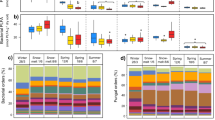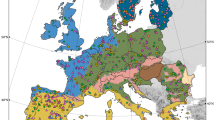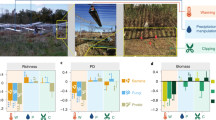Abstract
The temporal and spatial snow cover dynamics is the primary factor controlling the plant communities' composition and biogeochemical cycles in arctic and alpine tundra. However, the relationships between the distribution of snow and the diversity of soil microbial communities remain largely unexplored. Over a period of 2 years, we monitored soil microbial communities at three sites, including contiguous alpine meadows of late and early snowmelt locations (LSM and ESM, respectively). Bacterial and fungal communities were characterized by using molecular fingerprinting and cloning/sequencing of microbial ribosomal DNA extracted from the soil. Herein, we show that the spatial and temporal distribution of snow strongly correlates with microbial community composition. High seasonal contrast in ESM is associated with marked seasonal shifts for bacterial communities; whereas less contrasted seasons because of long-lasting snowpack in LSM is associated with increased fungal diversity. Finally, our results indicate that, similar to plant communities, microbial communities exhibit important shifts in composition at two extremes of the snow cover gradient. However, winter conditions lead to the convergence of microbial communities independently of snow cover presence. This study provides new insights into the distribution of microbial communities in alpine tundra in relation to snow cover dynamics, and may be helpful in predicting the future of microbial communities and biogeochemical cycles in arctic and alpine tundra in the context of a warmer climate.
Similar content being viewed by others
Log in or create a free account to read this content
Gain free access to this article, as well as selected content from this journal and more on nature.com
or
Accession codes
References
Altschul SF, Madden TL, Schaffer AA, Zhang JH, Zhang Z, Miller W et al. (1997). Gapped BLAST and PSI-BLAST: a new generation of protein database search programs. Nucleic Acids Res 25: 3389–3402.
Bais HP, Weir TL, Perry LG, Gilroy S, Vivanco JM . (2006). The role of root exudates in rhizosphere interactions with plants and other organisms. Annu Rev Plant Biol 57: 233–266.
Bardgett RD, Bowman WD, Kaufmann R, Schmidt SK . (2005). A temporal approach to linking aboveground and belowground ecology. TRENDS Ecol Evol 20: 634–641.
Beniston M, Fox DG, Adhikary S, Andressen R, Guisan A, Holten J et al. (1996). The impacts of climate change on mountain regions. Second Assessment Report of the Intergovernmental Panel on Climate Change (IPCC), Chapter 5. Cambridge University Press: Cambridge, UK. pp 191–213.
Billings WD . (1973). Arctic and alpine vegetations: similarities, differences, and susceptibility to disturbance. BioScience 23: 697–704.
Björk RG, Björkman MP, Andersson MX, Klemedtsson L . (2008). Temporal variation in soil microbial communities in alpine tundra. Soil Biol Biochem 40: 266–268.
Bowman WD, Theodose TA, Schardt JC, Conant RT . (1993). Constraints of nutrient availability on primary production in two apine tundra communities. Ecology 74: 2085–2097.
Butler JL, Williams MA, Bottomley PJ, Myrold DD . (2003). Microbial community dynamics associated with rhizosphere carbon flow. Appl Environ Microb 69: 6793–6800.
Chapman SK, Langley JA, Hart SC, Koch GW . (2006). Plants actively control nitrogen cycling: uncorking the microbial bottleneck. New Phytol 169: 27–34.
Chenna R, Sugawara H, Koike T, Lopez R, Gibson TJ, Higgins DG et al. (2003). Multiple sequence alignment with the Clustal series of programs. Nucleic Acids Res 31: 3497–3500.
Choler P . (2005). Consistent shifts in alpine plant traits along a mesotopographical gradient. Arct Antarct Alp Res 37: 444–453.
Cole JR, Chai B, Marsh TL, Farris RJ, Wang Q, Kulam SA et al. (2003). The Ribosomal Database Project (RDP-II): previewing a new autoaligner that allows regular updates and the new prokaryotic taxonomy. Nucleic Acids Res 31: 442–443.
Cottrell MT, Kirchman DL . (2000). Natural assemblages of marine proteobacteria and members of the Cytophaga–Flavobacter cluster consuming low- and high-molecular-weight dissolved organic matter. Appl Environ Microb 66: 1692–1697.
Crawford DL . (1978). Lignocellulose decomposition by selected Streptomyces strains. Appl Environ Microb 35: 1041–1045.
Davidson EA, Janssens IA . (2006). Temperature sensitivity of soil carbon decomposition and feedbacks to climate change. Nature 440: 165–173.
de Boer W, Folman LB, Summerbell RC, Boddy L . (2005). Living in a fungal world: impact of fungi on soil bacterial niche development. FEMS Microbiol Rev 29: 795–811.
Delbes C, Godon JJ, Moletta R . (1998). 16S rDNA sequence diversity of a culture-accessible part of an anaerobic digestor bacterial community. Environ Microbiol 4: 267–275.
Edwards AC, Scalenghe R, Freppaz M . (2007). Changes in the seasonal snow cover of alpine regions and its effect on soil processes: a review. Quatern Int 162: 172–181.
Falcon MA, Rodriguez A, Carnicero A, Regalado V, Perestelo F, Milstein O et al. (1995). Isolation of microorganisms with lignin transformation potential from soil of Tenerife island. Soil Biol Biochem 27: 121–126.
Farrar J, Hawes M, Jones D, Lindow S . (2003). How roots control the flux of carbon to the rhizosphere. Ecology 84: 827–837.
Fierer N, Bradford MA, Jackson RB . (2007). Toward an ecological classification of soil bacteria. Ecology 88: 1354–1364.
Fierer N, Jackson RB . (2006). The diversity and biogeography of soil bacterial communities. Proc Natl Acad Sci USA 103: 626–631.
Fisk MC, Schmidt SK, Seastedt TR . (1998). Topographic patterns of above- and below-ground production and nitrogen cycling in alpine tundra. Ecology 79: 2253–2266.
Gardes M, Dahlberg A . (1996). Mycorrhizal diversity in arctic and alpine tundra: an open question. New Phytol 133: 147–157.
Hobbie SE, Schimel JP, Trumbore SE, Randerson JR . (2000). Controls over carbon storage and turnover in high-latitude soils. Glob Change Biol 6: 196–210.
Huber T, Faulkner G, Hugenholtz P . (2004). Bellerophon: a program to detect chimeric sequences in multiple sequence alignments. Bioinformatics 20: 2317–2319.
Johansson JF, Paul LR, Finlay RD . (2004). Microbial interactions in the mycorrhizosphere and their significance for sustainable agriculture. FEMS Microbiol Ecol 48: 1–13.
Körner C . (1999). Alpine Plant Life. Springer Verlag: Berlin.
Lauber CL, Strickland MS, Bradford MA, Fierer N . (2008). The influence of soil properties on the structure of bacterial and fungal communities across land-use types. Soil Biol Biochem 40: 2407–2415.
Lipson DA, Schmidt SK . (2004). Seasonal changes in an alpine soil bacterial community in the Colorado Rocky Mountains. Appl Environ Microb 70: 2867–2879.
Lipson DA, Schimdt SK, Monson RK . (1999). Links between microbial population dynamics and nitrogen availability in an alpine ecosystem. Ecology 80: 1623–1631.
Litaor MI, Seastedt TR, Walker DA . (2001). Spatial analysis of selected soil attributes across an alpine topographic/snow gradient. Landscape Ecol 17: 71–85.
Marchesi JR, Sato T, Weightman AJ, Martin TA, Fry JC, Hiom SJ et al. (1998). Design and evaluation of useful bacterium-specific PCR primers that amplify genes coding for bacterial 16S rRNA. Appl Environ Microbiol 64: 795–799.
Marshall JD, Blair JM, Peters DPC, Okin G, Rango A, Williams M . (2008). Predicting and understanding ecosystem responses to climate change at continental scales. Front Ecol Environ 6: 273–280.
Martin F, Aerts A, Ahren D, Brun A, Danchin EGJ, Duchaussoy F et al. (2008). The genome of Laccaria bicolor provides insights into mycorrhizal symbiosis. Nature 452: 88–92.
Melillo JM, Steudler PA, Aber JD, Newkirk K, Lux H, Bowles FP et al. (2002). Soil warming and carbon-cycle feedbacks to the climate system. Science 298: 2173–2176.
Mille-Lindblom C, Fischer H, Tranvik LJ . (2006). Antagonism between bacteria and fungi: substrate competition and a possible tradeoff between fungal growth and tolerance towards bacteria. Oikos 113: 233–242.
Mougel C, Offre P, Ranjard L, Corberand T, Gamalero E, Robin C et al. (2006). Dynamic of the genetic structure of bacterial and fungal communities at different developmental stages of Medicago truncatula Gaertn. cv. Jemalong line J5. New Phytol 170: 165–175.
Oechel WC, Vourlitis GL, Hastings SJ, Zulueta RC, Hinzman L, Kane D . (2000). Acclimation of ecosystem CO2 exchange in the Alaskan Arctic in response to decadal climate warming. Nature 406: 978–981.
O'lear HA, Seastedt TR . (1994). Landscape patterns of litter decomposition in alpine tundra. Oecologia 99: 95–101.
Read DJ, Perez-Moreno J . (2003). Mycorrhizas and nutrient cycling in ecosystems—a journey towards relevance? New Phytol 157: 475–492.
Sait M, Davis KER, Janssen PH . (2006). Effect of pH on isolation and distribution of members of subdivision 1 of the phylum Acidobacteria occurring in soil. Appl Environ Microb 72: 1852–1857.
Sandhu GS, Kline BC, Stockman L, Roberts GD . (1995). Molecular probes for diagnosis of fungal-infections. J Clin Microbiol 33: 2913–2919.
Schadt CW, Martin AP, Lipson DA, Schmidt SK . (2003). Seasonal dynamics of previously unknown fungal lineages in tundra soils. Science 301: 1359–1361.
Schmalenberger A, Schwieger F, Tebbe CC . (2001). Effect of primers hybridizing to different evolutionarily conserved regions of the small-subunit rRNA gene in PCR-based microbial community analyses and genetic profiling. Appl Environ Microb 67: 3557–3563.
Schmidt SK, Costello EK, Nemergut DR, Cleveland CC, Reed SC, Weintraub MN et al. (2007). Biogeochemical consequences of rapid microbial turnover and seasonal succession in soil. Ecology 88: 1379–1385.
Schulte EE, Hopkins GG . (1996). Estimation of organic matter by weight loss-on-ignition. In: Magdoff F, Tabatabai MA, Hanlon EA (eds). Soil Organic Matter: Analysis and Interpretation. SSSA spec. Publ. 46. SSSA: Madison, WI. pp 21–31.
Schwarzenbach K, Enkerli J, Widmer F . (2007). Objective criteria to assess representativity of soil fungal community profiles. J Microbiol Meth 68: 358–366.
Smith B, Wilson JB . (1996). A consumer's guide to evenness indices. Oikos 76: 70–82.
Sogin ML, Morrison HG, Huber JA, Mark Welch D, Huse SM, Neal PR et al. (2006). Microbial diversity in the deep sea and the underexplored ‘rare biosphere’. Proc Natl Acad Sci USA 103: 12115–12120.
Stach JEM, Bathe S, Clapp JP, Burns RG . (2001). PCR-SSCP comparison of 16S rDNA sequence diversity in soil DNA obtained using different isolation and purification methods. FEMS Microbiol Ecol 36: 139–151.
The R Development Core Team (2007). R: A Language and Environment for Statistical Computing. R Foundation for Statistical Computing: Wien.
Waldrop MP, Zak DR, Blackwood CB, Curtis CD, Tilman D . (2006). Resource availability controls fungal diversity across a plant diversity gradient. Ecol Lett 9: 1127–1135.
Walker DA . (2000). Hierarchical subdivision of Arctic tundra based on vegetation response to climate, parent material and topography. Global Change Biol 6: 19–34.
Welker JM, Fahnestock JT, Jones MH . (2000). Annual CO2 flux in dry and moist arctic tundra: field responses to increases in summer temperatures and winter snow depth. Climatic Change 44: 139–150.
White TJ, Bruns T, Lee S, Taylor J . (1990). Amplification and direct sequencing of fungal ribosomal RNA genes for phylogenetics. In: Innis MA, Gelfand DH, Shinsky JJ, White TJ (eds). PCR Protocols: A Guide to Methods and Applications. Academic Press: San Diego. pp 315–322.
Yergeau E, Bokhorst S, Huiskes AHL, Boschker HTS, Aerts R, Kowalchuk GA . (2007a). Size and structure of bacterial, fungal and nematode communities along an Antarctic environmental gradient. FEMS Microbiol Ecol 59: 436–451.
Yergeau E, Newsham KK, Pearce DA, Kowalchuk GA . (2007b). Patterns of bacterial diversity across a range of Antarctic terrestrial habitats. Environ Microbiol 9: 2670–2682.
Zak DR, Kling GW . (2006). Microbial community composition and function across an arctic tundra landscape. Ecology 87: 1659–1670.
Zinger L, Gury J, Alibeu O, Rioux D, Gielly L, Sage L et al. (2008). CE-SSCP and CE-FLA, simple and high-throughput alternatives for fungal diversity studies. J Microbiol Meth 72: 42–53.
Zinger L, Gury J, Giraud F, Krivobok S, Gielly L, Taberlet P et al. (2007). Improvements of polymerase chain reaction and capillary electrophoresis single-strand conformation polymorphism methods in microbial ecology: toward a high-throughput method for microbial diversity studies in soil. Microb Ecol 54: 203–216.
Acknowledgements
We thank Pierre Taberlet, Jean-Marc Bonneville, Jerôme Gury, David Lejon (Laboratoire d'Ecologie Alpine) and Richard Bardgett (Lancaster University) for reading the paper, helpful suggestions and discussions, Armelle Monier for technical assistance; and Alice Roy and the Centre National de Séquençage (Genoscope, Evry) for sequencing the libraries; and Serge Aubert and the staff of Station Alpine J Fourier for providing logistic facilities during the field work. The study was supported by the ANR-06-BLAN-0301 ‘Microalpes’ project.
Author information
Authors and Affiliations
Corresponding author
Rights and permissions
About this article
Cite this article
Zinger, L., Shahnavaz, B., Baptist, F. et al. Microbial diversity in alpine tundra soils correlates with snow cover dynamics. ISME J 3, 850–859 (2009). https://doi.org/10.1038/ismej.2009.20
Received:
Revised:
Accepted:
Published:
Issue date:
DOI: https://doi.org/10.1038/ismej.2009.20
Keywords
This article is cited by
-
Vegetation as a key driver of the distribution of microbial generalists that in turn shapes the overall microbial community structure in the low Arctic tundra
Environmental Microbiome (2023)
-
Immediate and legacy effects of snow exclusion on soil fungal diversity and community composition
Forest Ecosystems (2021)
-
Effects of seasonal variation on soil microbial community structure and enzyme activity in a Masson pine forest in Southwest China
Journal of Mountain Science (2020)
-
Soil microbial community assemblage and its seasonal variability in alpine treeline ecotone on the eastern Qinghai-Tibet Plateau
Soil Ecology Letters (2019)
-
Soil legacy effects of climatic stress, management and plant functional composition on microbial communities influence the response of Lolium perenne to a new drought event
Plant and Soil (2018)



